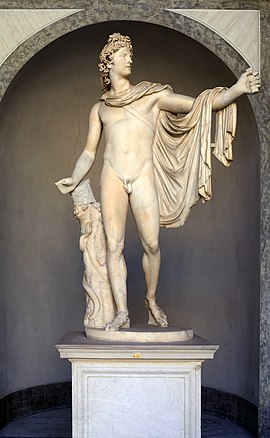| Apollo Belvedere | |
|---|---|
 | |
 Click on the map for a fullscreen view | |
| Artist | After Leochares |
| Year | c. AD 120–140 |
| Type | White marble |
| Dimensions | 224 cm (88 in) |
| Location | Vatican Museums, Vatican City |
| 41°54′23″N 12°27′16″E / 41.906389°N 12.454444°E | |
The Apollo Belvedere (also called the Belvedere Apollo, Apollo of the Belvedere, or Pythian Apollo)[1] is a celebrated marble sculpture from classical antiquity.
The work has been dated to mid-way through the 2nd century A.D. and is considered to be a Roman copy of an original bronze statue created between 330 and 320 B.C. by the Greek sculptor Leochares.[2] It was rediscovered in central Italy in the late 15th century during the Italian Renaissance and was placed on semi-public display in the Vatican Palace in 1511, where it remains. It is now in the Cortile del Belvedere of the Pio-Clementine Museum of the Vatican Museums complex.
From the mid-18th century it was considered the greatest ancient sculpture by ardent neoclassicists, and for centuries it epitomized the ideals of aesthetic perfection for Europeans and westernized parts of the world.
- ^ Réveil, Etienne Achille and Jean Duchesne (1828), Museum of Painting and Sculpture, or Collection of the Principal Pictures, Statues and Bas-Reliefs, in the Public and Private Galleries of Europe, London: Bossanage, Bartes and Lowell, Vol 11, p. 126. ("The Pythian Apollo, called the Belvedere Apollo")
- ^ "Belvedere Apollo". Vatican Museums. Archived from the original on 9 July 2023. Retrieved 2023-08-20.